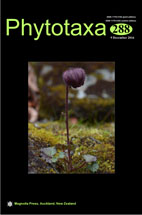Abstract
Molecular studies have recently led to major changes to the systematics of Boraginaceae and changed our perception of fruit morphology, previously used as the most important character in Boraginaceae classification. Navel-shaped nutlets as the key character for Omphalodes turned out to be highly homoplasious, thus the genus was revealed to be polyphyletic. After the recent reclassifications, the genus Omphalodes is still left paraphyletic, since the remaining taxa correspond to two different lineages: a clade of essentially Mediterranean perennials including the type species (O. verna) and a clade with the annual to subperennial North American taxa including the genus Mimophytum. We here advocate transferring all taxa of the North American clade into the genus Mimophytum, subdividing the genus Omphalodes into morphologically coherent and monophyletic entities. Mimophytum was initially removed from Omphalodes based on its glochidiate nutlets, but this character state does not define a monophyletic entity. In overall morphology, the redefined genus Mimophytum is highly homogeneous and easily differentiated from the other clades: it has a lax growth habit, and leaves are long-petiolate, abruptly contracted at the base into a more or less cordate base, and with a fine pubescence of erect trichomes. After the proposed rearrangements, only O. erecta remains as a problematic species whose systematic placement is still to be found out.

